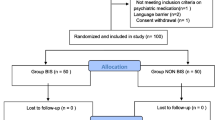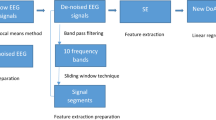Abstract
Bispectral index (BIS) is a processed EEG modality that monitors the hypnotic effect of general anesthetics. It has gained increased popularity as a simple monitor that gives valuable insight to the effect of various anesthetic agents on the cerebral cortex. BIS has been used for various endpoints such as preventing awareness, facilitating recovery from anesthesia, and decreasing anesthetic consumption.
Access provided by CONRICYT-eBooks. Download chapter PDF
Similar content being viewed by others
Keywords
-
1.
What is the monitoring modality seen in Fig. 13.1? Describe the numeric data fields and waveforms displayed on the screen.
-
2.
What are the clinical states that correspond to different BIS ranges?
-
3.
What is an acceptable BIS range for general anesthesia?
-
4.
Which anesthetic drugs are suitable for BIS to be used?
-
5.
List common indications for this monitoring modality in anesthesia practice.
-
6.
Besides anesthetic agents, what are some other conditions that can affect BIS?
Answers
-
1.
This is a bispectral index (BIS) monitor. BIS is a form of processed EEG that aims to monitor the effect of certain anesthetic medications in an objective fashion. Typically, a single channel of EEG obtained through a strip of skin electrodes over the forehead is acquired by the monitor and analyzed. The process that is used to compute the BIS involves several steps including artifact detection, power spectrum analysis, suppression detection, and fast Fourier transformation [1]. The end result is the “BIS,” a unitless number between 0 and 99 (Fig. 13.2). Other information available on the monitor are signal quality index (SQI), a semiquantitative EMG display, and the real-time EEG graph. Suppression ratio (the percentage of isoelectric EEG over a unit time) can also be displayed by turning that variable “on” in the menu. In the lower part of the screen in the picture, a moving trend of BIS is displayed for an overview. Although the algorithm aims to filter the EMG signal from analysis, the presence of EMG can introduce artifact and lead to falsely elevated BIS values.
-
2.
The range of BIS (0–99) can be divided into several zones in terms of clinical state of alertness and sedation [2]. The highest end of the BIS range (i.e., 92–99) corresponds to the EEG waveform of an awake individual. BIS in the high 80s to low 90s is consistent with light sedation. An individual with BIS in mid-80s is likely to fit in a state of “conscious sedation” (i.e., responds after name is called loudly). BIS in the high 70s to low 80s is a state of deep sedation (i.e., responds to shaking) with a potential for airway obstruction. Values lower than mid-70s are usually consistent with an anesthetized state. It is important to note that there is interindividual overlap between BIS ranges and degrees of sedation.
-
3.
BIS range of 45–60 corresponds to a state of general anesthesia. To be more precise, BIS is specifically an index of the hypnotic component of the general anesthetic state, measured through cerebral cortical electrical activity. Since movement to surgical stimulus is mediated largely by the spinal cord, immobility will not be ensured even in the lower end of this range. Equally important is the combination of anesthetics that is producing a certain BIS value: an individual with a BIS value of 50 with propofol alone is more likely to move with noxious stimulus, compared to the same individual with the same BIS value with a combination of propofol and remifentanil. However, explicit recall is highly unlikely with BIS values less than 60 [3], regardless of the anesthetic regimen employed. BIS values below 45 refer to a deep hypnotic state where side effects of anesthetics (e.g., hypotension, prolonged recovery) could be evident without a clear benefit. There have also been reports of increased long-term mortality associated with prolonged periods of BIS values below 45 [4]. Finally, burst suppression pattern starts around BIS of 30, with burst-suppression ratio gradually increasing to 100% as the BIS decreases to 0. In cases where cerebral protection is aimed by inducing burst suppression, BIS can be a useful tool [5].
-
4.
BIS is useful to monitor the hypnotic effect of volatile anesthetics (isoflurane, sevoflurane, desflurane), propofol, and etomidate. The addition of dexmedetomidine to a general anesthetic is also reflected on the BIS [6]. The effects of nitrous oxide or opioids on the hypnotic effect of an anesthetic agent are not reliably reflected on BIS monitoring [7, 8]. Finally, ketamine may lead to a paradoxical increase in BIS, while lower doses of it may not have any effect [9].
-
5.
BIS is not routinely indicated for all patients undergoing general anesthesia [10]. However, it is a useful tool in monitoring the hypnotic component of general anesthesia with volatile anesthetics as well as total intravenous anesthesia (TIVA) with propofol [11]. Compared to standard anesthesia practice, using BIS may decrease the risk of awareness, decrease anesthetic consumption, and modestly improve certain recovery profiles such as time to eye opening, time to extubation, and time to orientation [12].
-
6.
The spectrum of electromyographic (EMG) activity (30–200 Hz) is faster than that of EEG (0.5–30 Hz). The presence of EMG activity of the facial muscles often creates an artifact that results in an erroneously higher BIS value. Therefore, if the BIS readings are higher than what the clinical assessment suggests, reviewing the EMG display is helpful to rule this out. If NMBs are indicated, their administration will easily get rid of this artifact and enable an accurate BIS measurement. Electrocautery unit (ECU) is another common source of artifact. ECU, especially when a unipolar device is used for periods longer than 5 s, usually renders any meaningful measurement impossible. This would be evident in a decreased SQI value, and any interpretation of BIS should be postponed until SQI improves. Drugs that are beta-receptor agonists (e.g., isoproterenol) or antagonists (e.g., esmolol) have also been shown to increase or decrease BIS values, respectively [13, 14]. Clinical implications of these effects have not been established. Hypotension and hypothermia both result in decreases in BIS, probably related to decreased cerebral metabolic rate. Finally, baseline BIS values are often significantly lower (i.e., ranging from 75 to 90) in children with cerebral palsy as well as elderly with dementia. Although administration of anesthetics results in further decreases in BIS values from those baselines, interpretation of absolute values becomes more difficult in these populations since the algorithms have only been validated in individuals without underlying brain pathology.
References
Rampil IJ. A primer for EEG signal processing in anesthesia. Anesthesiology. 1998;89(4):980–1002.
Liu J, Singh H, White PF. Electroencephalographic bispectral index correlates with intraoperative recall and depth of propofol-induced sedation. Anesth Analg. 1997;84(1):185.
Myles PS, Leslie K, McNeil J, Forbes A, Chan MTV. Bispectral index monitoring to prevent awareness during anaesthesia: the B-Aware randomised controlled trial. Lancet. 2004;363(9423):1757–63. doi:10.1016/S0140-6736(04)16300-9.
Monk TG, Saini V, Weldon BC, Sigl JC. Anesthetic management and one-year mortality after noncardiac surgery. Anesth Analg. 2005;100(1):4–10. doi:10.1213/01.ANE.0000147519.82841.5E.
Bruhn J, Bouillon TW, Shafer SL. Bispectral index (BIS) and burst suppression: revealing a part of the BIS algorithm. J Clin Monit Comput. 2000;16(8):593–6.
Le Guen M, Liu N, Tounou F, et al. Dexmedetomidine reduces propofol and remifentanil requirements during bispectral index-guided closed-loop anesthesia a double-blind, placebo-controlled trial. Anesth Analg. 2014;118(5):946–55. doi:10.1213/ANE.0000000000000185.
Ozcan MS, Ozcan MD, Khan QS, Thompson DM, Chetty PK. Does nitrous oxide affect bispectral index and state entropy when added to a propofol versus sevoflurane anesthetic? J Neurosurg Anesthesiol. 2010;22(4):309–15. doi:10.1097/ANA.0b013e3181e4b7c8.
Lysakowski C, Dumont L, Pellégrini M, Clergue F, Tassonyi E. Effects of fentanyl, alfentanil, remifentanil and sufentanil on loss of consciousness and bispectral index during propofol induction of anaesthesia. Br J Anaesth. 2001;86(4):523–7. doi:10.1093/bja/86.4.523.
Sengupta S, Ghosh S, Rudra A, Kumar P, Maitra G, Das T. Effect of ketamine on bispectral index during propofol – fentanyl anesthesia: a randomized controlled study. Middle East J Anesthesiol. 2011;21(3):391–5.
American Society of Anesthesiologists Task Force on Intraoperative Awareness. Practice advisory for intraoperative awareness and brain function monitoring: a report by the American society of anesthesiologists task force on intraoperative awareness. Anesthesiology. 2006;104(4):847–64.
Johansen JW. Update on bispectral index monitoring. Best Pract Res Clin Anaesthesiol. 2006;20(1):81–99.
Punjasawadwong Y, Boonjeungmonkol N, Phongchiewboon A. Bispectral index for improving anaesthetic delivery and postoperative recovery. Cochrane Database Syst Rev. 2007;(4):CD003843. doi:10.1002/14651858.CD003843.pub2.
Gautam NK, Rafique MB, Numan MT. Impact of isoproterenol infusion on BIS and metabolic values in pediatric patients undergoing electrophysiology studies. J Clin Anesth. 2014;26(8):611–5. doi:10.1016/j.jclinane.2014.05.007.
Johansen JW. Esmolol promotes electroencephalographic burst suppression during propofol/alfentanil anesthesia. Anesth Analg. 2001;93(6):1526–31–table of contents.
Author information
Authors and Affiliations
Corresponding author
Editor information
Editors and Affiliations
Rights and permissions
Copyright information
© 2017 Springer International Publishing AG
About this chapter
Cite this chapter
Ozcan, M.S. (2017). Bispectral Index. In: Raj, T. (eds) Data Interpretation in Anesthesia. Springer, Cham. https://doi.org/10.1007/978-3-319-55862-2_13
Download citation
DOI: https://doi.org/10.1007/978-3-319-55862-2_13
Published:
Publisher Name: Springer, Cham
Print ISBN: 978-3-319-55861-5
Online ISBN: 978-3-319-55862-2
eBook Packages: MedicineMedicine (R0)






